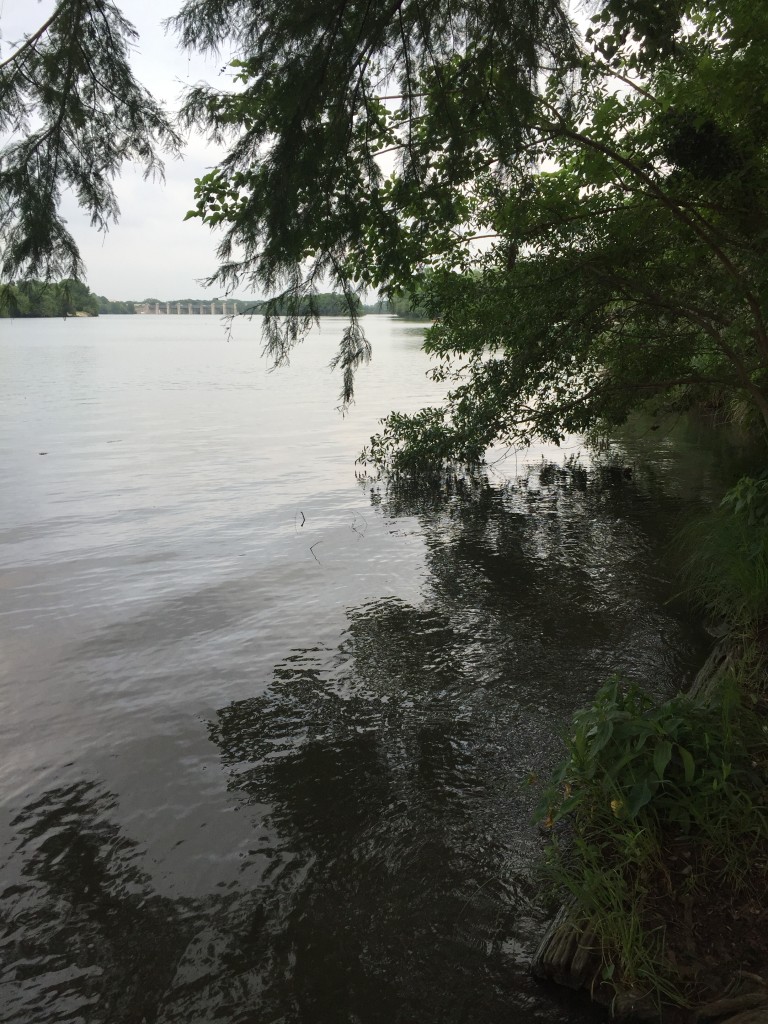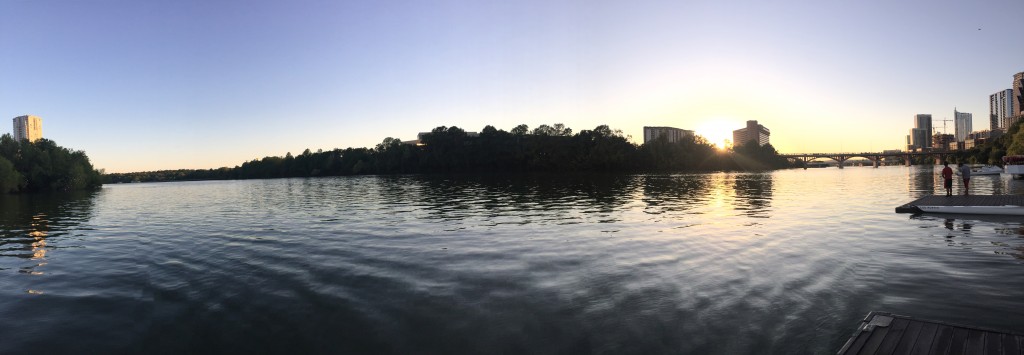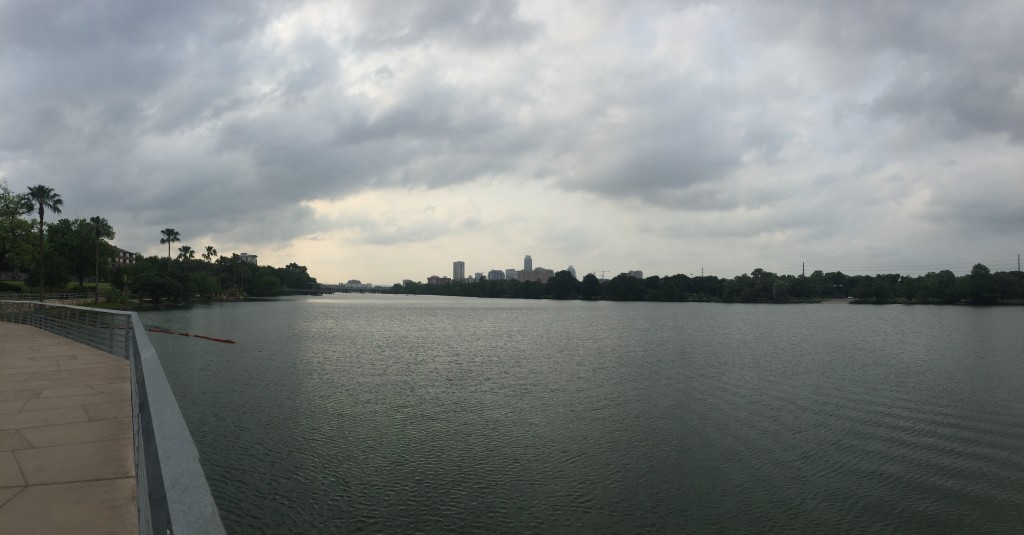“Most human beings have an almost infinite capacity for taking things for granted.”
― Aldous Huxley
During the last weeks of April, Austin experienced heavy rainstorms. To manage the water level on the west side of Tom Miller Dam, floodgates were opened to relieve the drowning riverbanks. Hundreds of gallons of water flowed into Lady Bird Lake, traveling east and picking up any floating item along the way. In the days that followed, the water smelt of sulfur and the river sediment remained invisible beneath the water’s surface. Standing on the dock overlooking Lady Bird Lake, I stared out at a river I no longer recognized.The water rushed by at a speed unusual to our current. New garbage and debris drifted to the wooden docks of Austin Rowing Club, getting trapped along the shore. And the strangest arrival came at the end of
the floodgate week. Half a dozen dead, large, white fished washed up to our docks. While working along Lady Bird Lake, I have not seen this happen after a flood or heavy rain in Austin. But it is yet another reminder that the local ecosystems are continually changing with every passing month. Interestingly enough, there are larger scale events happening in other areas of the United States[1,7]. This got me thinking, what type of contaminants would do this to our ecosystems. If pollutants were killing our local fish, what is present in our water that we cannot detect? How safe is our drinking water after all?
Throughout the United States, the Environmental Protection Agency provides national standards and regulations for water treatment facilities. Facilities across the nation must uphold state and federal guidelines established for assuring safe, clean, and secure drinking water for American citizens[2]. While our local water treatment plants look for nearly two hundred chemicals, it is not possible for all chemical remnants to be accounted. According to Kathleen Bower, the United Nations declared water sanitation and clean drinking water to be a basic human right[3]. To uphold this right, it is essential that all individuals be provided safe water for consumption and usage. As a developed nation, the United States has established safe drinking water standards. Our framework for water allocation is already in place. In other developing nations, the governance of water is not established in the same framework as the United States, if at all established[4].
Costa Rica is a quickly developing country in Central America. Their economy continues to grow with ecotourism becoming a huge market player. While the nation is known as one of the most sustainable, environmentally aware nations in the world, they still have their own environmental issues. For example, the Rio Tarcoles is one of the most polluted stream systems in Central America[3]. Further, access to clean drinking water is a rising issue in Costa Rica. Potable water, drinking water improved to meet standards for safe consumption, is only available to 82% of civilians. As a result, money is spent on treating waterborne illnesses rather than spending to prevent illness by the implementation of sewage treatment and water supply protection. As Costa Rica expands as a nation, steps are being taken to implement water resource development[3].
the Rio Tarcoles is one of the most polluted stream systems in Central America[3]. Further, access to clean drinking water is a rising issue in Costa Rica. Potable water, drinking water improved to meet standards for safe consumption, is only available to 82% of civilians. As a result, money is spent on treating waterborne illnesses rather than spending to prevent illness by the implementation of sewage treatment and water supply protection. As Costa Rica expands as a nation, steps are being taken to implement water resource development[3].
Today, community-based drinking water organizations (CWDWOs) are a major source of drinking water in rural areas. According to Madrigal et al., during the early nineteen-sixties, the Costa Rican government established the ICAA (Instituto Costarricense de Acueductos y Alcantarillados) responsible for the overseeing the allocation of domestic drinking water. This entity helped urban and rural areas develop facilities and means to acquire safe drinking water. Since then, community-based organizations have become the most prevalent provider in domestic water for rural areas. Unfortunately, the quality of water by CWDWO providers is not equal across the board. There is a large variance in the safety of the water. Thus, a new plan to develop water resource management is in question[5].
While it may be the simplest answer, a general remediation approach is not the solution to improving Costa Rica’s water quality. These general remediation solutions are known as panaceas. Ostrom et al. describe panaceas as “a blueprint for a single type of governance system that is applied to all environmental problems.” These simple models are based upon success in few areas[4]. However, a panaceas solution rarely considers local institutional and physical factors which impact allocation success. There are many factors that impact the best method to distribute domestic water that range from socio-economic to local factors. As Costa Rica further develops as a nation, it will be important to consider the diversity of each area[6]. Before racing forward, it is essential to develop proper planning methods and strategies in order for the continual preservation of the nation’s natural resources in tandem with industrial, economic, and domestic development.
remediation solutions are known as panaceas. Ostrom et al. describe panaceas as “a blueprint for a single type of governance system that is applied to all environmental problems.” These simple models are based upon success in few areas[4]. However, a panaceas solution rarely considers local institutional and physical factors which impact allocation success. There are many factors that impact the best method to distribute domestic water that range from socio-economic to local factors. As Costa Rica further develops as a nation, it will be important to consider the diversity of each area[6]. Before racing forward, it is essential to develop proper planning methods and strategies in order for the continual preservation of the nation’s natural resources in tandem with industrial, economic, and domestic development.
As we travel to Costa Rica in the upcoming week, I cannot help but be filled with anticipation and wonderment. I feel that Costa Rica will be vastly different from life in the United States in their environmental consciousness. I hope to expand my knowledge through observation of the differences in environmental and water quality of Costa Rica. It excites me to know that I will have a first-hand look at the eco-tourism and sustainability of the nation we have learnt so much about.
[1] Bartolatta, Devin. “DNR investigating large fish kill in Whitewater river.” KTTC http://www.kttc.com/story/29684210/2015/07/31/dnr-investigating-large-fish-kill-in-whitewater-river
[2] “Water Quality Reports”. Austin Water. https://www.austintexas.gov/department/drinking-water-quality-report
[3] Bower, Kathleen. “Water supply and sanitation of Costa Rica”. Environmental Earth Sciences. http://eds.a.ebscohost.com/eds/detail/detail?nobk=y&sid=61a96200-687c-42ff-9129-9f524b0a4a98@sessionmgr4003&vid=3&hid=4213&bdata=JnNpdGU9ZWRzLWxpdmUmc2NvcGU9c2l0ZQ==#db=agr&AN=IND500717861
[4] Ostrom, Elinor, Janssen, Marco, Anderies, John. “Going beyond panaceas”. Proceedings of the National Academy of Science. http://www.pnas.org/content/104/39/15176
[5] Madrigal-Ballestero, Roger; Alpizar, Francisco; Schluter, Achim. “Public perceptions of the performance of community-based drinking water organizations in Costa Rica”. Water Resources and Rural Development. http://resolver.ebscohost.com.ezproxy.stedwards.edu/openurl?sid=EBSCO%3aedselp&genre=article&issn=22126082&ISBN=&volume=1-2&issue=&date=20131101&spage=43&pages=43-56&title=Water+resources+and+rural+development&atitle=Public+perceptions+of+the+performance+of+community-based+drinking+water+organizations+in+Costa+Rica&aulast=Madrigal-Ballestero%2c+R%C3%B3ger&id=DOI%3a10.1016%2fj.wrr.2013.10.001&site=ftf-live
[6] Agrawal, Arun. “Common Property Institutions and Sustainable Governance of Resources”. World Development. http://ac.els-cdn.com/S0305750X01000638/1-s2.0-S0305750X01000638-main.pdf?_tid=43cf1ede-14b2-11e6-a626-00000aab0f6b&acdnat=1462666835_5c7705dfc8c04da8c59d5267d1301205
[7] Contreras, Cindy. “Thirty Years of Investigating Fish and Wildlife Kills and Pollution in Texas”. Texas Parks and Wildlife. https://tpwd.texas.gov/landwater/water/environconcerns/kills_and _spills/30yrs.phtml

